360-Degree Camera Market Size
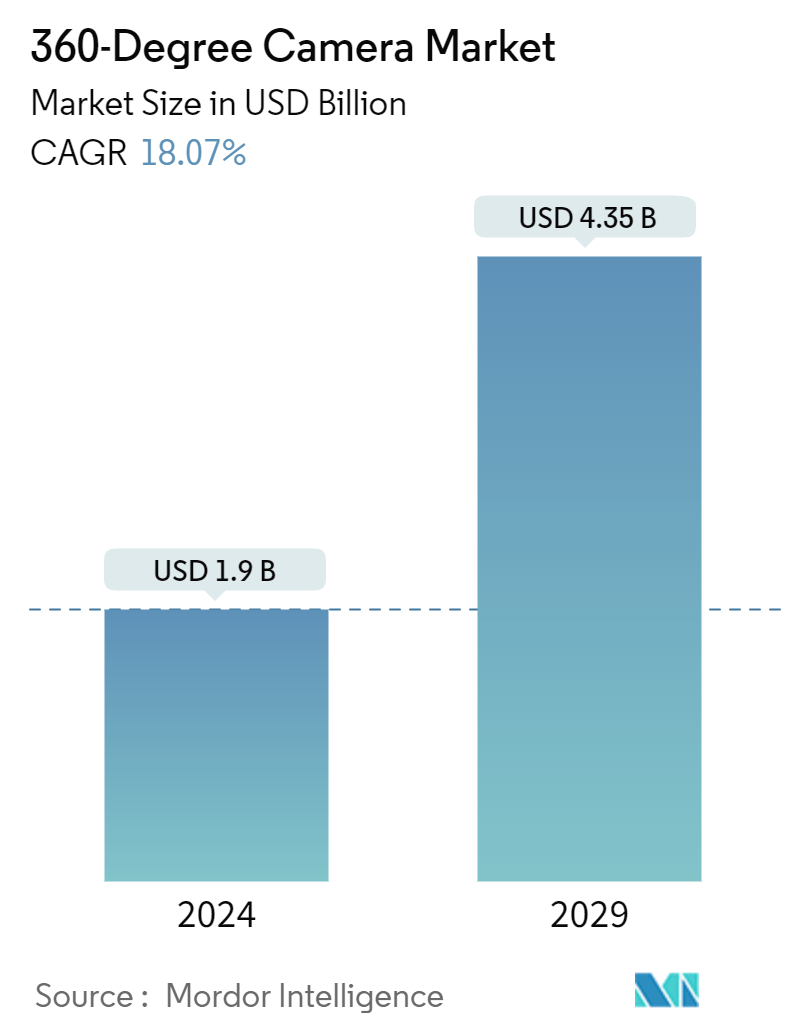
| Study Period | 2019 - 2029 |
| Market Size (2024) | USD 1.9 Billion |
| Market Size (2029) | USD 4.35 Billion |
| CAGR (2024 - 2029) | 18.07 % |
| Fastest Growing Market | Asia Pacific |
| Largest Market | North America |
Major Players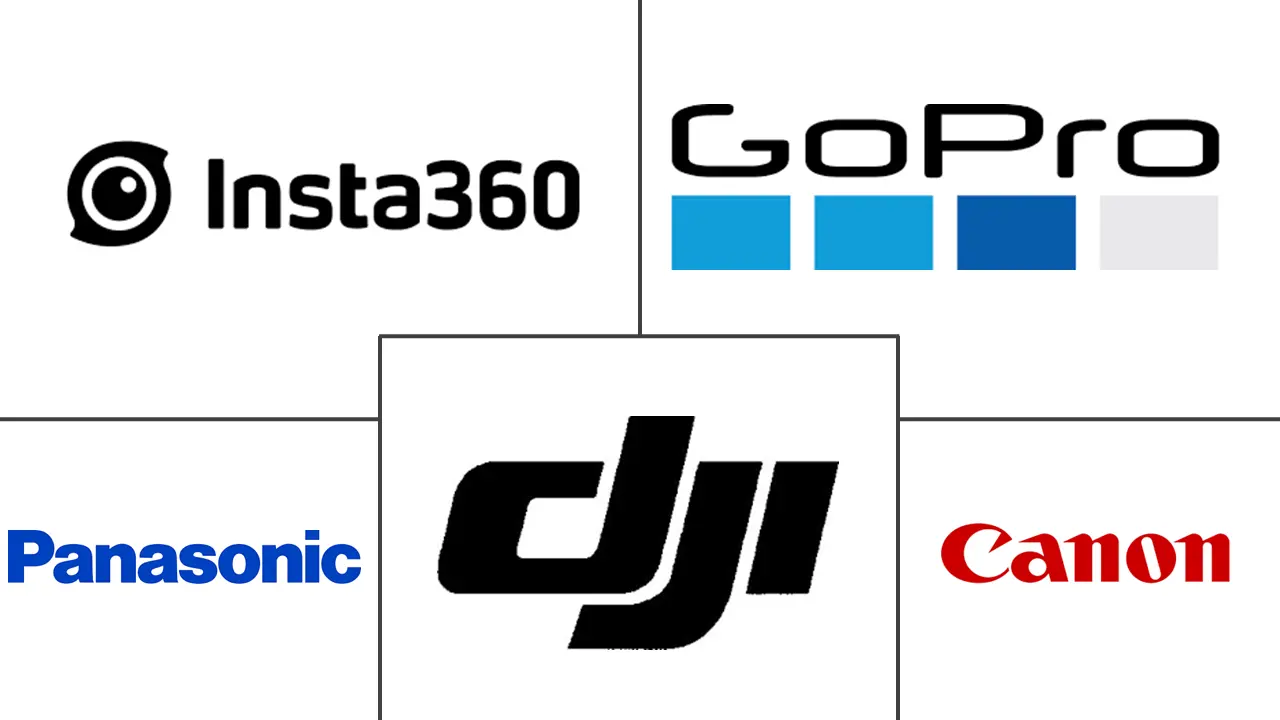
*Disclaimer: Major Players sorted in no particular order |
360-Degree Camera Market Analysis
The 360-Degree Camera Market size is estimated at USD 1.9 billion in 2024, and is expected to reach USD 4.35 billion by 2029, growing at a CAGR of 18.07% during the forecast period (2024-2029).
- Camera technology, image processing algorithms, and lens design have seen significant advancements, leading to notable improvements in the image and video quality of 360-degree cameras. With enhancements like higher resolutions, superior low-light performance, minimized distortion, and better color accuracy, these cameras now excel at capturing high-quality, immersive content.
- AI-driven image and video processing algorithms empower 360-degree cameras with advanced capabilities. These include automatic stitching and blending of feeds for seamless content creation, real-time image stabilization and horizon leveling for smoother playback, and intelligent object tracking and recognition for enriched video analytics.
- Further, as an increasing number of industries recognize the advantages of 360-degree cameras, the market continues to expand, creating new opportunities for manufacturers, developers, and service providers. This diversification across various sectors significantly drives the growth of the 360-degree camera market. For example, the media and entertainment industry has been at the forefront of adopting 360-degree cameras. They've utilized these cameras for immersive content creation, virtual reality experiences, live event streaming, and cutting-edge advertising campaigns. With the rising demand for captivating and interactive content, this industry continues to play a vital role in augmenting the growth of the 360-degree camera market.
- However, such cameras provide an all-encompassing view of their surroundings, raising significant privacy concerns. Their deployment in public areas, workplaces, or homes has sparked debates about potential infringements on individual privacy rights. In addition, these cameras generate vast amounts of data, including sensitive visual information, leading to concerns about data security and the risks of breaches or unauthorized access. To safeguard the privacy and security of this captured data, it's essential to implement robust data storage protocols, encryption methods, and stringent access controls.
- The IMF forecasts a drop in the global CPI inflation rate, predicting a decline from 5.8% this year to 4.4% in the coming year. A lower inflation rate bolsters consumers' purchasing power, which could elevate demand for discretionary items, such as 360-degree cameras. Additionally, this reduced inflation rate affects commodity prices and the costs of raw materials essential for producing these cameras. Consequently, this decline in inflation is poised to positively influence the purchasing capability of consumers, creating a favourable ecosystem for the studied market's growth.
360-Degree Camera Market Trends
Media and Entertainment End-User Industry is Expected to Hold Significant Market Share
- 360-degree cameras are revolutionizing content creation in the media and entertainment industry, producing high-demand immersive visuals. These cameras capture panoramic visuals, seamlessly integrating into formats like virtual reality (VR) experiences, 360-degree videos, and interactive content.
- As the media and entertainment industry evolves, consumers consistently seek fresh, captivating experiences that fully immerse them. 360-degree cameras meet this demand, crafting content that transports viewers across diverse environments and perspectives.
- The media and entertainment industry is pioneering the adoption of virtual reality (VR) and augmented reality (AR) technologies. It relies heavily on 360-degree cameras, which are essential for capturing 360-degree footage and imagery and form the backbone of immersive VR and AR experiences. The industry also increasingly adopts 360-degree cameras for live event streaming and recording, including concerts, sports events, and conferences. These cameras enable viewers to engage with events from various angles, enriching the overall viewing experience.
- As global demand for AR/VR devices surges, the market is poised for substantial growth. For example, the Consumer Technology Association (CTA) estimates that revenue from augmented reality headsets and eyewear in the United States was projected to hit USD 188 billion last year, a significant jump from USD 78 billion previously.
- Over the years, the global influencer market has grown significantly. This burgeoning market for influencers and content creators bodes well for the industry, especially as filmmakers, content creators, and production studios increasingly turn to 360-degree cameras. These cameras help capture distinctive and visually arresting footage for movies, documentaries, and other entertainment. By offering a 360-degree viewpoint, these cameras elevate storytelling and the cinematic experience, underscoring their significance in the media and entertainment realm.
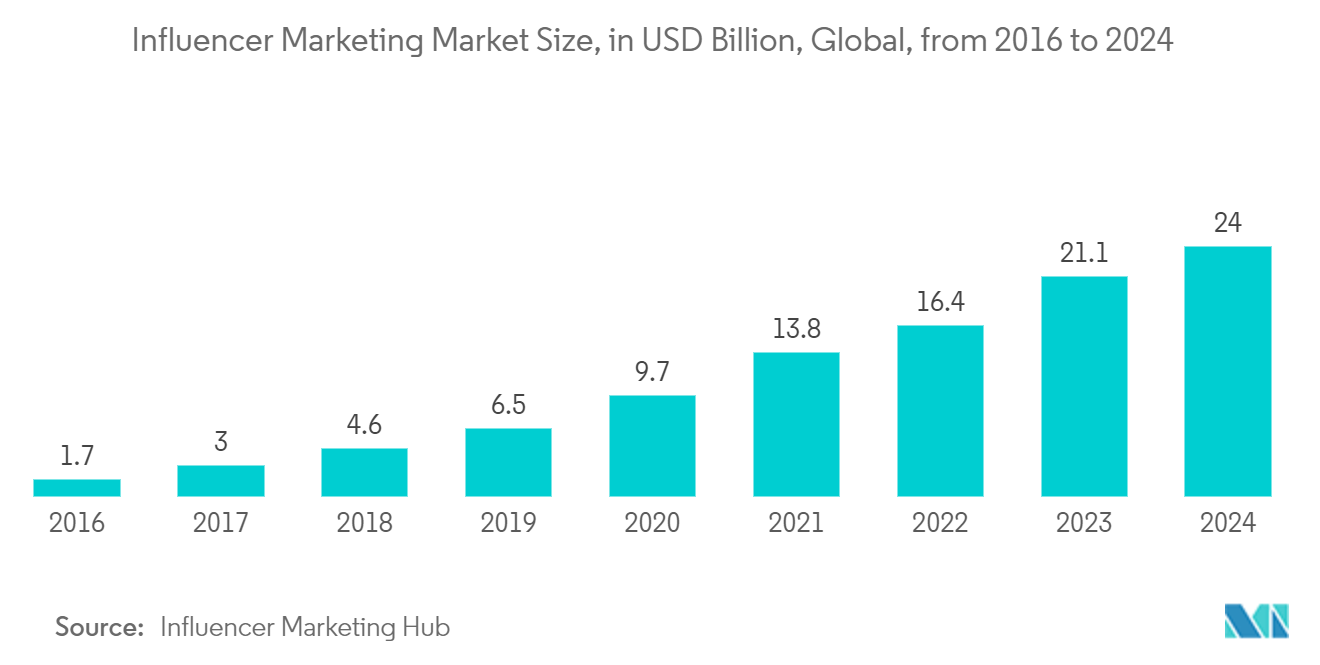
North America is Expected to Hold Significant Market Share
- North America boasts a strong presence of leading 360-degree camera manufacturers, including GoPro, Ricoh, and Insta360. These companies have acquired a significant market share, built robust distribution networks, executed impactful marketing campaigns, and achieved notable brand recognition in the region. In October last year, GoPro, the US-based company, launched the Hero 12 Black action camera, boasting features like an 8:7 aspect ratio sensor, vertical video capability, HDR support, Bluetooth microphone compatibility, and additional enhancements.
- The regional consumers' eagerness to adopt cutting-edge technologies significantly propels market growth. This trend is further amplified by the surging popularity of VR/AR and an escalating demand for immersive content creation. Moreover, increasing security incidents and the consequent need for thorough monitoring have spurred the adoption of 360-degree cameras across North America's commercial, public, and residential spaces.
- The region boasts a well-developed infrastructure for high-speed internet, 5G networks, and cloud computing, essential for the seamless integration and utilization of 360-degree cameras in various applications. This strong technological foundation supports the efficient capture, storage, and sharing of 360-degree content, further driving market growth.
- In North America, especially in the US, government initiatives and policies have been pivotal in fostering the development and adoption of advanced technologies. Through measures like R&D funding, tax incentives, and regulatory backing, these initiatives have cultivated a conducive atmosphere for the expansion of the 360-degree camera market in the region.
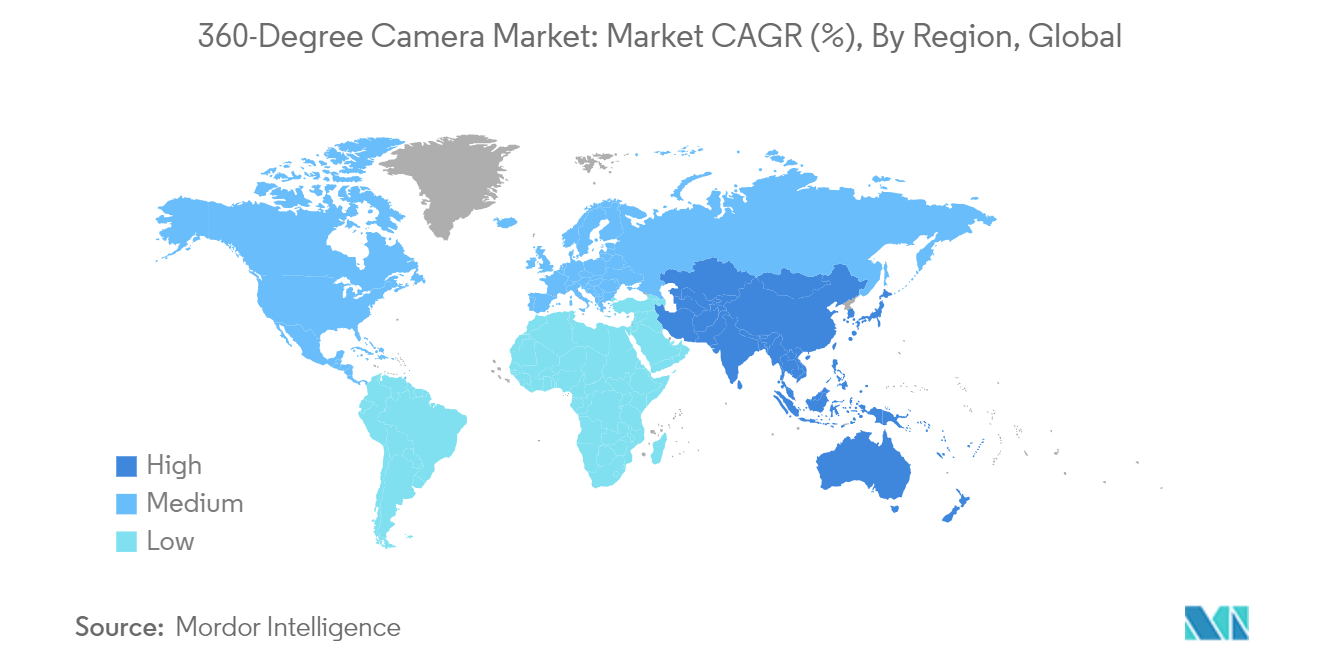
360-Degree Camera Industry Overview
The 360-degree camera market is fragmented in the presence of several players. Key players invest in research and development to broaden their product offerings, poised to further propel the market's growth. These market participants are also actively pursuing strategies to enhance their global presence. Notable activities include launching new products, mergers and acquisitions, increasing investments, and collaborating with other entities. Some key players include Insta360 (Arashi Vision Inc.), GoPro, Inc., SZ DJI Technology Co. Ltd, Panasonic Holdings Corporation, and Canon Inc.
- April 2024 - Insta360 launched its flagship camera, the Insta360 X4, which boasts an impressive 8K 360-degree video capability. Additionally, it supports 5.7K at 60 frames per second and 4K at 100 fps. It features an invisible selfie stick effect and a single-lens mode that operates as a 4K/60p action camera. The introduction of the 8K video mode marks a milestone, being the highest resolution ever offered by Insta360 in a 360-degree action camera. This ensures sharp and detailed 360-degree footage and highlights the advantage of 8K resolution.
- April 2024 - Insta360 Enterprise formed a strategic partnership with Cupix. This collaboration sees Insta360's premium 6K 360 camera, the ONE RS 1-inch 360 Edition, fully integrated and supported within CupixWorks and CupixVista. This integration provides built-world professionals with high-quality, user-friendly, and efficient digital twin solutions. The partnership aims to enhance enterprise applications, offering premium image quality and outstanding low-light performance. This enables the creation of immersive panoramic views, 3D point clouds, and textured meshes that accurately represent as-built conditions.
360-Degree Camera Market Leaders
-
Insta360 (Arashi Vision Inc)
-
GoPro, Inc.
-
SZ DJI Technology Co., Ltd.
-
Panasonic Holdings Corporation
-
Canon Inc.
*Disclaimer: Major Players sorted in no particular order
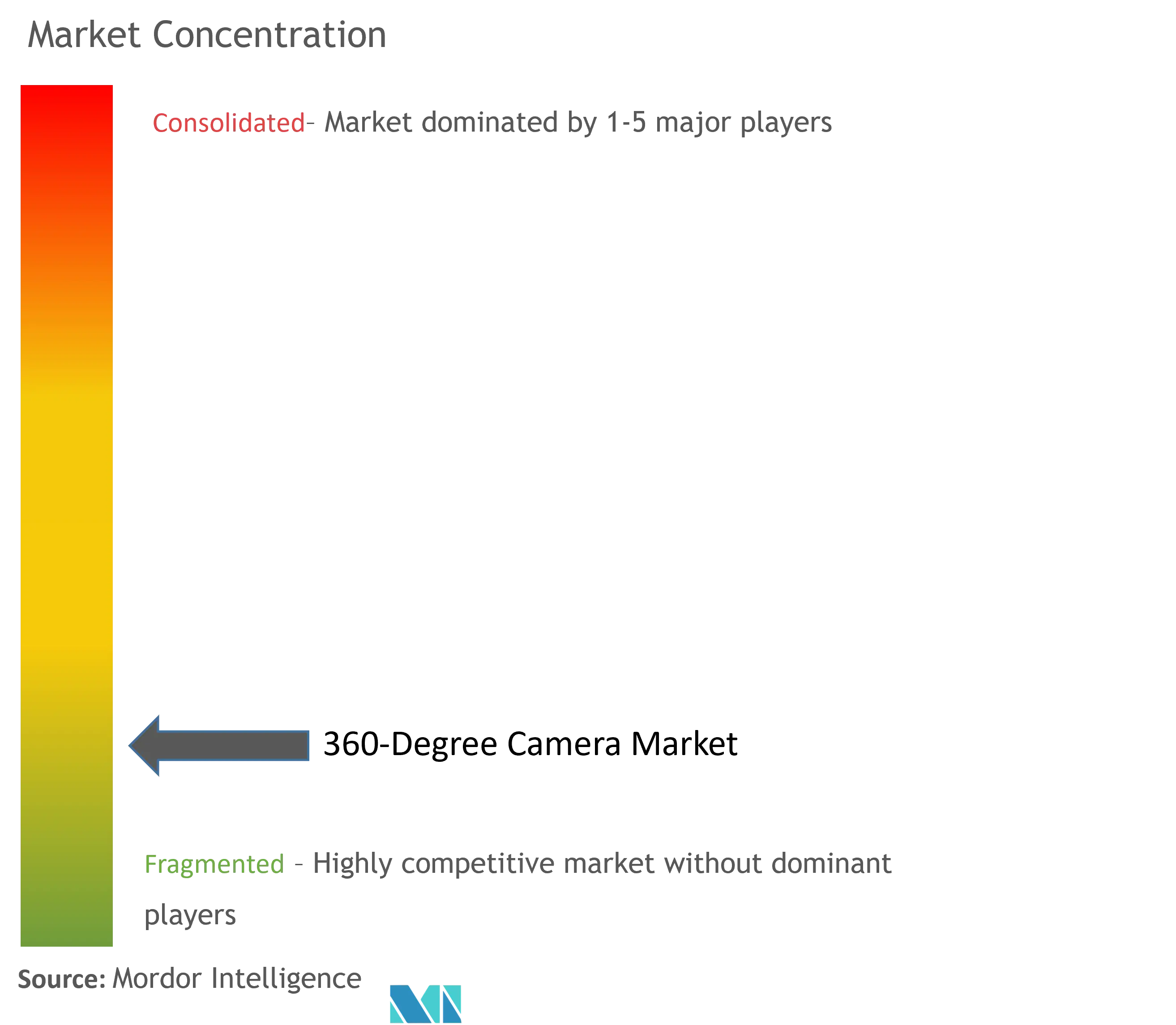
360-Degree Camera Market News
- May 2024 - Bounce Imaging launched two innovative 360-degree tactical cameras: the Recce360TW throwable camera and the Land Shark TW K9. These cutting-edge devices incorporate TrellisWare’s mobile ad hoc network (MANET) radio modules, ensuring extended range, improved interoperability for situational awareness, and heightened resistance to electronic warfare (EW) disruptions. Additionally, the systems are equipped with TrellisWare’s TW-650 TSM Shadow Core board module, enabling them to function as a long-range payload, seamlessly collaborating with other uncrewed vehicles.
- January 2024 - Ricoh and Cupix forged a strategic partnership, seamlessly integrating Cupix products with Ricoh's THETA X. This collaboration ensures that Ricoh's latest 360-degree camera, the THETA X, is now fully compatible with CupixWorks and CupixVista. Due to this alliance, the RICOH THETA X 360-degree cameras are deployed as essential tools for 4D as-built documentation, adeptly addressing the evolving demands of the built-world industries.
360-Degree Camera Market Report - Table of Contents
1. INTRODUCTION
- 1.1 Study Assumptions and Market Definition
- 1.2 Scope of the Study
2. RESEARCH METHODOLOGY
3. EXECUTIVE SUMMARY
4. MARKET INSIGHTS
- 4.1 Market Overview
-
4.2 Industry Attractiveness - Porter's Five Forces Analysis
- 4.2.1 Bargaining Power of Suppliers
- 4.2.2 Bargaining Power of Consumers
- 4.2.3 Threat of New Entrants
- 4.2.4 Threat of Substitutes
- 4.2.5 Intensity of Competitive Rivalry
- 4.3 Industry Value Chain Analysis
- 4.4 Impact of Macroeconomic Trends on the Market
5. MARKET DYNAMICS
-
5.1 Market Drivers
- 5.1.1 Technological Advancements
- 5.1.2 Expanding Applications Across Diverse Industries
-
5.2 Market Restraint
- 5.2.1 Concerns Arise over Ethical Protocols and Privacy Breaches in the Technology's Application
6. MARKET SEGMENTATION
-
6.1 By Connectivity Type
- 6.1.1 Wired
- 6.1.2 Wireless
-
6.2 By Resolution
- 6.2.1 High-Definition (HD)
- 6.2.2 Ultra-High-Definition (UHD)
-
6.3 By End-User Industry
- 6.3.1 Media and Entertainment
- 6.3.2 Consumer
- 6.3.3 Military and Defense
- 6.3.4 Travel and Tourism
- 6.3.5 Automotive
- 6.3.6 Commercial
- 6.3.7 Healthcare
-
6.4 By Geography***
- 6.4.1 North America
- 6.4.2 Europe
- 6.4.3 Asia
- 6.4.4 Australia and New Zealand
- 6.4.5 Latin America
- 6.4.6 Middle East and Africa
7. COMPETITIVE LANDSCAPE
-
7.1 Company Profiles*
- 7.1.1 Insta360 (Arashi Vision Inc)
- 7.1.2 GoPro, Inc.
- 7.1.3 SZ DJI Technology Co., Ltd.
- 7.1.4 Panasonic Holdings Corporation
- 7.1.5 Sony Group Corporation
- 7.1.6 Canon Inc.
- 7.1.7 Nikon Corporation
- 7.1.8 FeiyuTech
- 7.1.9 Samsung Electronics
- 7.1.10 LG Electronics
- 7.1.11 Ricoh Co., Ltd.
- 7.1.12 Kodak Pixpro (JK Imaging)
- 7.1.13 Panono (Professional360 GmbH)
- 7.1.14 YI Technology
- 7.1.15 Immervision
- 7.1.16 Olympus Corporation
- 7.1.17 Kandao
- 7.1.18 SRS Microsystems
- 7.1.19 Wodsee Electronics Limited
8. INVESTMENT ANALYSIS
9. FUTURE OF THE MARKET
** Subject To Availablity360-Degree Camera Industry Segmentation
A 360 camera (omnidirectional camera) has a 360-degree field of view to capture around the sphere. These cameras are essential for covering expansive visual fields, such as in panoramic shots. With the increasing importance of virtual and augmented reality (AR/VR) in video games and interactive entertainment, the demand for 360 cameras has surged. The study tracks the revenue from selling such cameras in several end-user industries. It also tracks underlying growth trends and macroeconomic trends impacting the market.
The 360-degree camera market is segmented by connectivity type (wired and wireless), resolution (high-definition (HD), and ultra-high-definition (UHD)), end-user industry (media and entertainment, consumer, military and defense, travel and tourism, automotive, commercial, and healthcare), and geography (North America, Europe, Asia, Australia and New Zealand, Latin America, and Middle East and Africa). The market sizes and forecasts for all the above segments are provided in value (USD).
| By Connectivity Type | Wired |
| Wireless | |
| By Resolution | High-Definition (HD) |
| Ultra-High-Definition (UHD) | |
| By End-User Industry | Media and Entertainment |
| Consumer | |
| Military and Defense | |
| Travel and Tourism | |
| Automotive | |
| Commercial | |
| Healthcare | |
| By Geography*** | North America |
| Europe | |
| Asia | |
| Australia and New Zealand | |
| Latin America | |
| Middle East and Africa |
360-Degree Camera Market Research FAQs
How big is the 360-Degree Camera Market?
The 360-Degree Camera Market size is expected to reach USD 1.9 billion in 2024 and grow at a CAGR of 18.07% to reach USD 4.35 billion by 2029.
What is the current 360-Degree Camera Market size?
In 2024, the 360-Degree Camera Market size is expected to reach USD 1.9 billion.
Who are the key players in 360-Degree Camera Market?
Insta360 (Arashi Vision Inc), GoPro, Inc., SZ DJI Technology Co., Ltd., Panasonic Holdings Corporation and Canon Inc. are the major companies operating in the 360-Degree Camera Market.
Which is the fastest growing region in 360-Degree Camera Market?
Asia Pacific is estimated to grow at the highest CAGR over the forecast period (2024-2029).
Which region has the biggest share in 360-Degree Camera Market?
In 2024, the North America accounts for the largest market share in 360-Degree Camera Market.
What years does this 360-Degree Camera Market cover, and what was the market size in 2023?
In 2023, the 360-Degree Camera Market size was estimated at USD 1.56 billion. The report covers the 360-Degree Camera Market historical market size for years: 2019, 2020, 2021, 2022 and 2023. The report also forecasts the 360-Degree Camera Market size for years: 2024, 2025, 2026, 2027, 2028 and 2029.
360-Degree Camera Industry Report
Statistics for the 2024 360-Degree Camera market share, size and revenue growth rate, created by Mordor Intelligence™ Industry Reports. 360-Degree Camera analysis includes a market forecast outlook for 2024 to 2029 and historical overview. Get a sample of this industry analysis as a free report PDF download.



